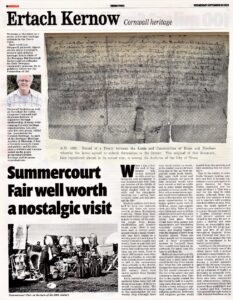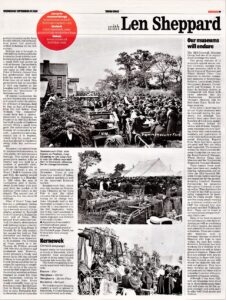Summercourt Fair well worth a nostalgic visit
Many of the images are courtesy of the Royal Cornwall Museum and we thank them for allowing us to publish them here. Good quality images are available from their website via this link. Image Archive Royal Cornwall Museum
These late 19th and early 20th century images of Summercourt Fair would probably closely resembled the type of fairs held for many centuries before the mechanised fun fairs became the norm.
When I was a boy the end of September was looked forward to with great anticipation and excitement. It was Summercourt Fair time and besides all the thrills of the fairground there was the street market with all the stalls and the cheapjack’s shouting out selling their crockery, linen, pots and pans and the like.
Markets and fairs have been held far back into medieval times and there are many records of these throughout Cornwall. These may have been held within a larger community to which all the outlying people from farms, smallholding and hamlets would come. Often it may have been a central point, around which a small community may have begun as a starting point of a new town. A market took place usually on a weekly basis on a set date and it would have only been larger towns that could sustain more than one per week. Prior to about 1200 markets were often held on a Sunday, to coincide with visits to church and then to add to the convenience often actually in the churchyard. Increasingly during the 13th century there were moves against these Sunday markets.
Early markets and fairs in medieval times were very different from many of those we would recognise today. The markets were like to us going to the supermarket for our weekly shop although there were retail outlets in towns. At the market you would have been able to buy all your immediate needs meat, butter, fish, eggs, cloth metal and wooden utensils. All sorts of farm livestock would have been traded as well as crafts and at some larger markets probably overseas goods. The fairs, not so numerous as markets would have had many features of the markets, but with many opportunities to buy higher quality goods such as clothing, spices, high quality cloth and silks. Sales of livestock hides and wool as well as administrative activities such as paying rents and hire of labour took place. There would have been games and amusements and wandering minstrels playing instruments and singing together with the sharing of news from faraway places. These are where people met to socialise and to meet prospective spouses. In Cornwall, these fairs would have been an opportunity for small time tinners to sell their tin.
Medieval times saw a profusion of saint’s days and often if there was a local saint that would be the day of the annual fair. From the 13th century it became the usual practice that the fair would commence on the eve of the saint’s day and continue to the day after. Similar to the regular market the fair would be held at a particular place, this may have been within a town setting or perhaps under the auspices of a religious authority. Both town and religious parties would benefit from the markets and fairs receiving fees for allowing it.
Due to the ability to raise funds through holding markets and fairs it became considered a royal prerogative to grant licences for these events, especially into the reign of Henry I. This was a way for the king to raise money, although there was care for new markets or fairs not to interfere with existing ones held within an area. It became the usual method of granting a new market or fair to a town through the issue of a Charter, however towns with historic markets and owned by the king did not require a charter and were known as prescriptive markets. By 1516 75% of all markets and 86% of all fairs throughout England, Wales and Cornwall had been created by royal grants the rest could be considered to be mainly prescriptive
Looking at the situation in Cornwall to firstly one of the oldest places with a market would have been Padstow. Evidence of an early urban situation usually pointed to it having a market specially prior to the Norman Conquest in 1066. Alfred the Great had set up a number of burh’s or boroughs as primarily fortified settlements that would have also been commercial and administrative centres. and it is extremely likely that most of these would have had a market and fair. Padstow was granted borough status in 1306. Padstow had been an important monastic centre from the 6th century, but ecclesiastical power had gradually shifted to Bodmin by the 11th century. Bodmin was a borough in 1086 and was mentioned in the Domesday Book with the market belonging to St Petroc and a small town had grown up with 68 houses. The market is recorded at Bodmin in 1201 and again in 1302 when the Prior of Bodmin claimed that his predecessors had held both the market and the fair from time out of mind. This prescriptive fair as recorded in 1274 was known as the Longfair and it would in time become the forerunner of Summercourt Fair.
Of course, Launceston the earliest Norman seat of power in Cornwall under the authority of Robert of Mortain, held by him as Earl of Cornwall from his half bother King William ‘the conqueror’ would have had a market. Mentioned in Domesday as Dunhevet in 1086 Earl Robert had built a castle at Dunhevet around which a small town grew. The earlier close by settlement of Launceston (Cornish – Lannstevan) meaning, church site of St Stephen, which held the market saw that transferred to Dunhevet along with the settlement name. The priory also moved from St Stephens to Launceston in 1155 and by 1201 had become a borough. This market was a prescriptive market with no charter and was held by a number of powerful earls. Reginald de Dunsterville as Earl of Cornwall a son of Henry I held it between 1155 and 1165, the market moved from a Sunday to a Thursday in 1206 when the men of Launceston paid 5 marks, about £2,500 today with rent paid from the market of 20 shillings (£730 today) to the church. The annual cost of holding the fair was about 50 shillings
What of Truro? Truro had become a settlement during the mid-12th century becoming a borough around 1173 by charter granted by Reginald Earl of Cornwall to Richard de Luci lord of Truro. This granted Truro status in Cornwall, but shortly afterwards to gain national status a charter was granted by King Henry II himself. By the 13th century the annual fair held on 11th November and weekly markets in Truro were important to its economy. The lordship of Truro passed to a Sir Thomas de Pridyas around 1300, who was an abusive and tyrannical man. However, under pressure a treaty was drawn up in 1307 that allowed Pridyas to have profits of the Courts Baron and of the fair in return for agreeing to comply with the terms of the charter issued by Earl Reginald. Over the coming centuries as times changed so would the rules and regulations relating to markets and fairs. Truro would eventually have up to four fairs a year, the Mid-Lent Fair in March, the Whitsun Fair in June, Fortnights Fair in December and of course the ancient medieval fair held in November. Truro is now home to a number of indoor and outdoor markets as well as the important livestock market.
Summercourt Fair, which was also known as Penhale, Long Chipping or the Long Fair is now the oldest recorded fair in Cornwall, allowing for its change locations. Originally held on 14th September a change in the calendar by 11 days moved it to the 25th September. Sadly, due to this year’s pandemic it was cancelled, but many thousands of people look forward to its return in 2021.
![Summercourt Fair c1900 [RCM 6] Summercourt Fair c1900 [RCM]](https://www.cornwallheritage.com/wp-content/uploads/2020/10/Summercourt-Fair-c1900-RCM-6.jpg)
![Summercourt Fair c1900 [RCM 5] Summercourt Fair c1900 [RCM]](https://www.cornwallheritage.com/wp-content/uploads/2020/10/Summercourt-Fair-c1900-RCM-5-300x217.jpg)
![Summercourt Fair c1900 [RCM 4] Summercourt Fair c1900 [RCM]](https://www.cornwallheritage.com/wp-content/uploads/2020/10/Summercourt-Fair-c1900-RCM-4-300x209.jpg)
![Summercourt Fair c1900 [RCM 3] Summercourt Fair c1900 [RCM]](https://www.cornwallheritage.com/wp-content/uploads/2020/10/Summercourt-Fair-c1900-RCM-3-300x178.jpg)
![Summercourt Fair c1900 [RCM 2] Summercourt Fair c1900 [RCM]](https://www.cornwallheritage.com/wp-content/uploads/2020/10/Summercourt-Fair-c1900-RCM-2-300x208.jpg)
![Summercourt Fair c1900 [RCM 1] Summercourt Fair c1900 [RCM]](https://www.cornwallheritage.com/wp-content/uploads/2020/10/Summercourt-Fair-c1900-RCM-1-300x179.jpg)
![Summercourt Fair c1900 [RCM 7] W. Teague of 23 Station Street, Newport, Monmouth selling herbal remedies with a lady assistant dressed in Welsh costume. The fair was a Charter fair dating back to 1227 and was held at Lower Penhale. It moved to Summercourt in 1711. The fair was held on 25th September and was originally for cattle and horses. Photographer: Arthur William Jordan.](https://www.cornwallheritage.com/wp-content/uploads/2020/10/Summercourt-Fair-c1900-RCM-7-300x218.jpg)
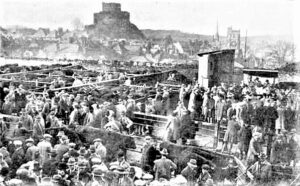
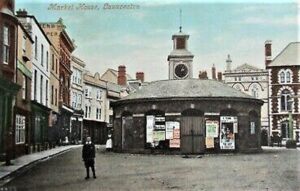
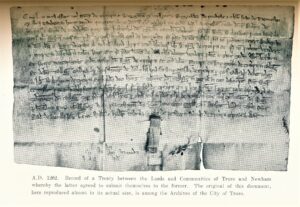
![Fair at Truro Cornwall c1910 Fair at Truro Cornwall c1910 [RCM]](https://www.cornwallheritage.com/wp-content/uploads/2020/10/Fair-at-Truro-Cornwall-c1910-300x209.jpg)
